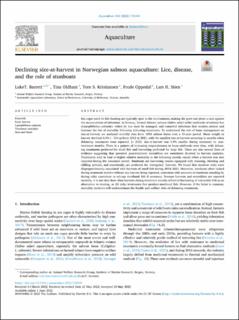| dc.description.abstract | Sea cages used for fish farming are typically open to the environment, making the grow-out phase a race against the accumulation of infections. In Norway, farmed Atlantic salmon (Salmo salar) suffer outbreaks of salmon lice (Lepeophtheirus salmonis), which by law must be managed, and comorbid infections that weaken salmon and increase the risk of mortality following delousing treatments. To understand the role of louse management on size-at-harvest, we analysed monthly data from 1054 salmon farms over a 10-year period. Mean weight at harvest declined 6.6% (−310 g) from 2012 to 2021, with the smallest size-at-harvest occurring in months when delousing treatments were reported. In 2021, size-at-harvest was 3.4% smaller during treatment vs. non-treatment months. There is a pattern of increasing responsiveness to louse outbreaks over time, with delousing treatments preferred for small fish and harvesting preferred for large fish. There are also several lines of evidence suggesting that potential post-treatment mortalities are sometimes diverted to harvest statistics. Treatments tend to lead to higher relative mortality in the following month, except when a harvest was also reported during the treatment month. Stunboats are harvesting vessels equipped with stunning, bleeding and chilling systems, and anecdotally, are preferred for ‘emergency’ harvests. We found that stunboat visits were disproportionately associated with harvests of small fish during 2018–2021. Moreover, stunboats often visited during treatment months without any harvest being reported, consistent with accounts of stunboats standing by during risky operations to salvage moribund fish if necessary. Because harvests and mortalities are reported monthly, it is not clear how often harvests during treatment months reflect (i) harvesting of vulnerable fish as an alternative to treating, or (ii) risky treatments that produce moribund fish. However, if the latter is common, mortality statistics will underestimate the health and welfare risks of delousing treatments. | en_US |
